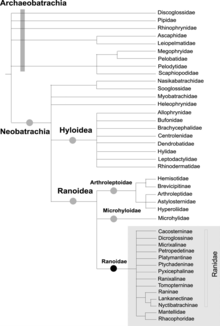Ranoidea
| Ranoidea | |
|---|---|
 | |
| Darwin's frog (Rhinoderma darwinii) | |
| Scientific classification | |
| Kingdom: | Animalia |
| Phylum: | Chordata |
| Class: | Amphibia |
| Order: | Anura |
| Suborder: | Neobatrachia |
| Superfamily: | Ranoidea |
| Families [2] | |
|
... | |
The Ranoidea are a superfamily of frogs in the order Anura. Members of this superfamily are characterised by having the pectoral girdle fused into a single complex unit, having no ribs, and using an axillary grip during amplexus. The larvae have a single spiracle on the left side and complex mouthparts, or in some species, undergo direct development.[3]
This superfamily contains seventeen different families, each containing at least 2 species (some contain over 300 different species).[4][5] (See figure 1).
Families[4][6]
Ranixalidae:
The family of Ranixalidae (Leaping Frogs) has one genus containing 10 different species. They can be found in central and southern India. They typically reside in leaf litter and in tropical deciduous forests, near streams and can be found between 200m and 1100m in altitude.
Mantellidae:
The family of Mantellidae (Malagasy Poison Frogs) has three different genera with 191 species total. They can be found in Madagascar and Mayotte Island. They are both terrestrial and arboreal frogs and can be found between 800 and 1000m in altitude.
Rhacophoridae:
The family of Rhacophoridae (Afroasian Tree Frogs) has two subfamilies, 14 genera, and a total of 321 species. They are found in Sub-Saharan Africa, Madagascar, and South Asia. They are mainly tree frogs. They have intercalary cartilage between their last two phalanges.
Pyxicephalidae:
The family of Pyxicephalidae (African Bullfrogs) has two subfamilies, 13 genera, and 68 total species. They are also found in Sub-Saharan Africa. The two subfamilies are completely different in that cacosternines are small and slender typically terrestrial or semiaquatic, whereas pyxicephalines are large bullfrog like frogs that have stocky bodies, with fang like projections on their lower jaw, used to smash their prey.
Petropedetidae:
The family of Petropedetidae (African Water Frogs and Goliath Frog) has two genera with a total of 18 different species. They are found in Sub-Saharan Africa. This family contains the world's largest frog, Conraua goliath.
Ptychadenidae:
The family of Ptychadenidae (Grassland Frogs) has 3 genera with a total of 53 different species. They are found in sub-Saharan Africa. They reside in grasslands and savannas. They tend to have slender bodies with long limbs.
Ceratobatrachidae:
The family of Ceratobatrachidae (Triangle Frogs) has 5 genera with a total of 84 different species. They can be found in Malaysia, Philippines, Borneo, New Guinea, and the Solomon Islands. Most have very angular bodies and are small to moderate in size. They live in the forests.
Brevicipitidae:
The family of Brevicipitidae (Rain frogs) has 5 genera with 31 total species. They can be found in Sub-Saharan African in the south east corner. They are typically small with spherical shaped bodies, which become even more round when they are disturbed because they inflate themselves as a mode of defense.

References
- ↑ "Superfamily Ranoidea Rafinesque 1814 (frog)". Paleobiology Database. Fossilworks. Retrieved 18 June 2018.
- ↑ Cannatella, David; Ford, Linda; Bockstanz, Lori (1995). "Neobatrachia". Tree of Life Web Project. Retrieved 2012-09-24.
- ↑ Duellman, William E.; Zug, George R. "Anura: Critical appraisal". Encyclopædia Britannica. Retrieved 2012-09-24.
- 1 2 Vitt, Laurie J. & Caldwell, Janalee P. (2014). Herpetology: An Introductory Biology of Amphibians and Reptiles (4th ed.). Academic Press. ISBN 9780123869197. OCLC 839312807.
- ↑ Van der Meijden, Arie (2006-01-01). "Molecular phylogeny and biogeography of ranoid frogs".
- ↑ "AmphibiaWeb". amphibiaweb.org. Retrieved 2018-04-29.